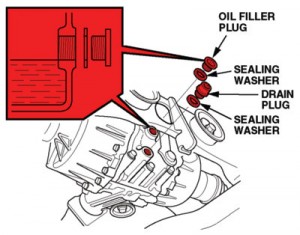Model year: 2003-‘04
If a customer brings a 2003-’04 Honda Pilot to the shop with a noise and shake from the rear when turning, the cause and repair of the problem can be simple: The differential fluid may be contaminated by clutch particles, condensation, or both. Contamination will cause the differential clutches to make noise and judder when turning.
To duplicate the problem, do 10 figure-eight patterns with the steering wheel at full lock. Listen for a noise and feel for a judder. Accelerate at the start of each circle to make sure the clutches engage and disengage. Do not use the VTM-4 LOCK button. As an alternative to doing figure-eight patterns, you may do 10 circles to the left and 10 circles to the right instead. If you can hear the noise and feel the judder, follow the service procedure to make the repair. Replacing the contaminated differential fluid will usually solve the problem.
 Service Procedure
Service Procedure1. Raise the vehicle on a lift in the level position with the engine turned off.
2. Remove the oil filler plug and its sealing washer. Save the sealing washer.
3. Remove the drain plug and its sealing washer and drain the differential fluid. Save the sealing washer.
NOTE: The drained fluid should look red. If it looks pink, it means water entered the differential through the vent tube breather in the rear sub-frame. This can happen after launching a boat or driving through water deep enough to cover the tires. If the fluid looks pink, replacing the fluid may not eliminate the noise and judder.
4. Clean the drain plug then reinstall it with the sealing washer you saved in step 3. Torque the drain plug to 47 Nm (35 ft.-lbs).
5. Fill the differential with Honda’s VTM-4 differential fluid or equivalent until the fluid level is at the bottom of the filler hole.
6. Reinstall the oil filler plug with the sealing washer you saved in step 2. Torque the oil filler plug to 47 Nm (35 ft.-lbs).
7. Drive the vehicle in figure-eight or circle patterns as previously described. You may need to perform up to 10 patterns to get rid of the noise and judder.
8. Raise the vehicle on a lift in the level position with the engine off.
9. Remove the oil filler plug and its sealing washer. Discard the sealing washer.
10. Remove the drain plug and its sealing washer and drain the differential fluid. Discard the sealing washer.
11. Clean the drain plug, then reinstall it with a new 18 mm sealing washer. Torque the drain plug to 47 Nm (35 ft.-lbs).
12. Fill the differential again until the fluid level is at the bottom of the filler hole.
13. Reinstall the oil filler plug with a new 20 mm sealing washer. Torque the oil filler plug to 47 Nm (35 ft.-lbs).
Test drive the vehicle again as previously described to make sure the noise and judder are gone. Complete at least 10 patterns.
Courtesy of the ALLDATA® Community Automotive Diagnostic Team, a select group of automotive experts dedicated to helping technicians fix hard-to-repair vehicles efficiently. Read more at support.alldata.com/alldata-community.
© 2014 ALLDATA LLC.
 Service Procedure
Service Procedure Service Procedure
Service Procedure Service Procedure
Service Procedure






